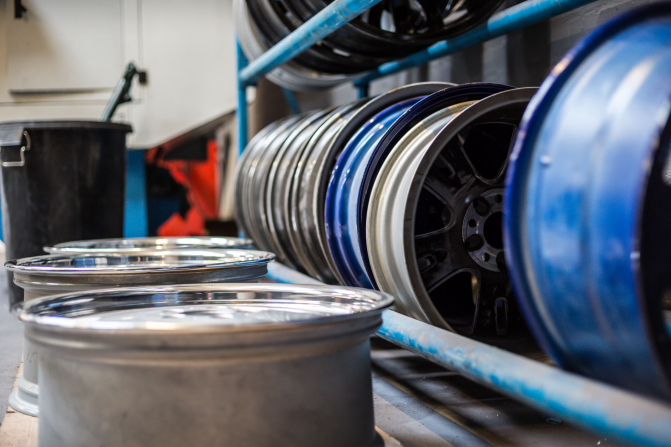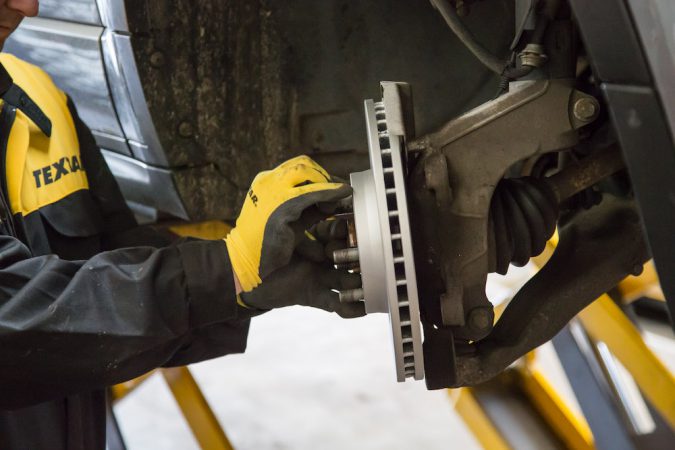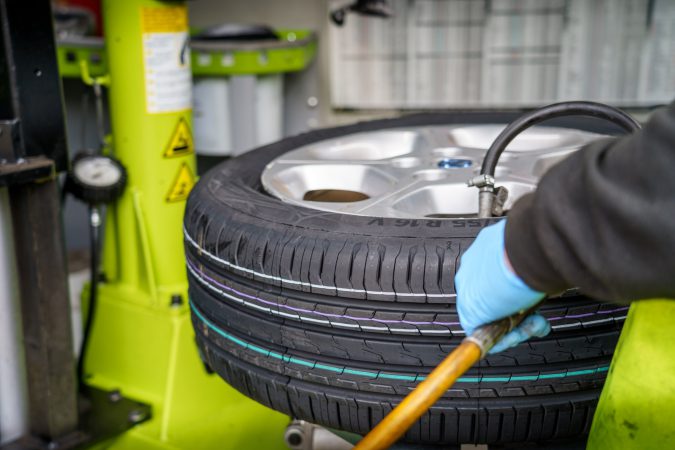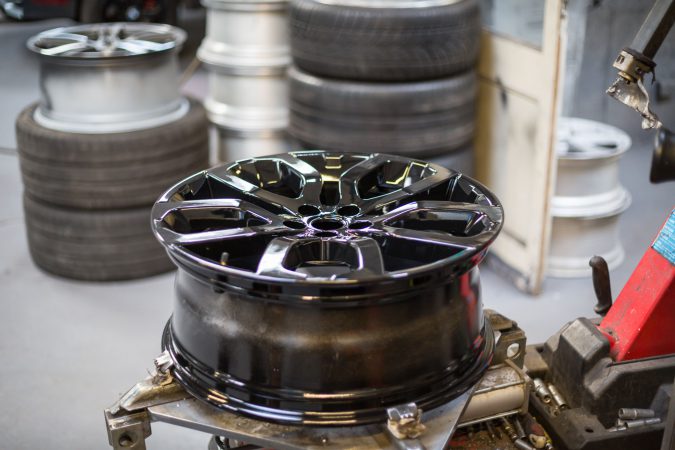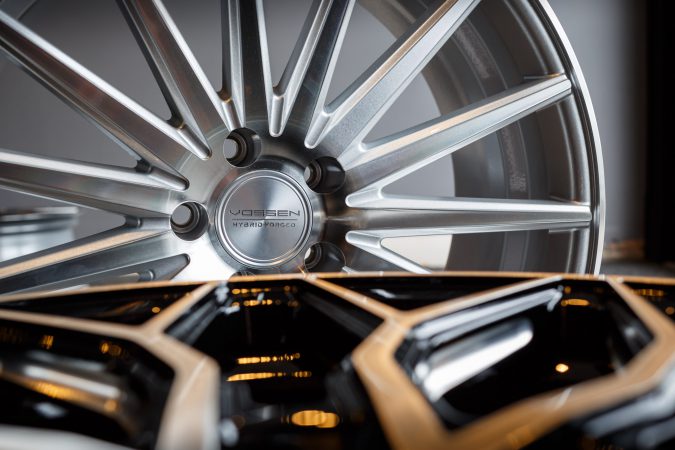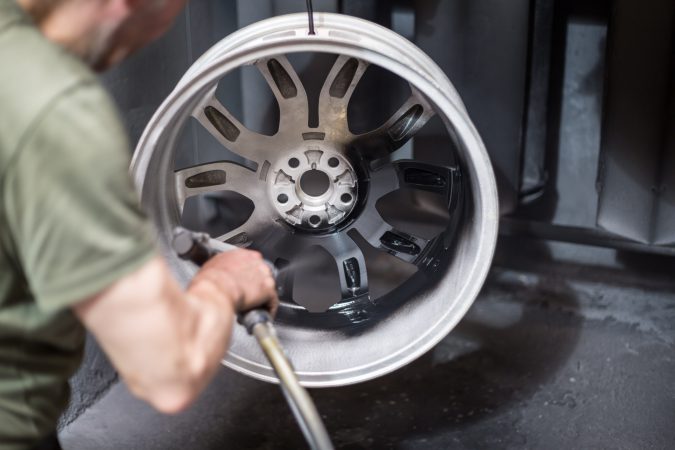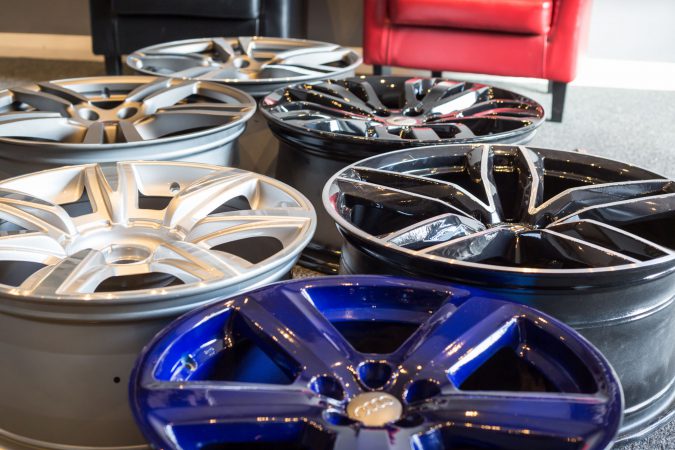While we do talk a lot about a car’s tires, there’s seldom mention of the wheels that it’s fitted on. But then again, there are few reasons to think much about the wheels… Until you’d accidentally curbed it and need repairs. Ouch, I feel you. With that being said, there are times when you’re keen to swap the wheels for something sleeker to nicer. In that case, knowing how to read rim size will be crucial.
Naturally, you can sort of understand right off the bat that fitting wrongly-sized rims onto your car is a terrible idea. For starters, the tires that you already have might not fit. In addition, those oversized wheels might rub against the wheel well, as well as interrupt your car’s steering and suspension. Not ideal in any regard. For that reason, it’s good to take a moment to know how to read rim size?
- What’s In A Wheel?
- Sections Of The Wheel
- How To Read?
- What The Numbers Mean
- Extra Measurements
- Final Thoughts
What’s The Difference Between A Wheel And A Rim?
Before we get into discussing how to read rim size, there’s a common misunderstanding that we need to clear up. Admittedly, it’s quite a common mistake to make, even on my part. However, this is worth a mention… A wheel and a rim are not the same thing, and can’t so easily be interchangeable. That’s especially so when you’re getting a new wheel fitted on, and it’s vital to spot the differences.
In truth, the rim is only one of many varying sections that make up the wheels. As such, when you’re using the term ‘rim’, it specifically references the outer edge of the wheel. This here is what holds the tire in place, supporting its beads and keeping it from flying off as you drive. Meanwhile, ‘wheel’ is used to define the entire wheel assembly (including the rim) that supports the tires, and holds it all together.
Thus, learning how to read rim size is essentially focused on the outer edge of the wheels alone. If we look closer at the anatomy of the rim, it’s usually U-shaped. In other words, it’s deeper in the center of the rim, flanked up by raised sides, which contributes to its ability to keep the tires in place. The rim is often made from the same material as the wheel but may include additional layers for protection.
And while we’re here, a breakdown of the wheels unravel several other key sections and components worth discussing besides the rim:
- Bearings
- Hub
- Fasteners
- Valves
For a more thorough description, here’s what each of those individual parts does:
1. Bearings – A Vital Connection Between The Wheel And Your Car
If you’re wondering about how your car’s rotating wheels can stay connected to a stationary vehicle, we can thank the wheel bearings for this. Besides keeping the wheels in place and maintaining a solid connection with the car, the bearings help to create a low friction fitment with the wheels.
Every wheel bearing is made to be anti-friction bearings. This ensures that the wheel can roll around without a significant loss of momentum, and enable it to do so smoothly. The wheel bearings have a few individual components of their own:
- Inner Race – Sometimes called a ‘cone’, it’s the part of the bearing its directly on the driveshaft.
- Rolling Element – Designed like balls or rollers, they provide cushioning to smoothen out friction.
- Outer Race – As the exterior ring, it protects the bearing’s internals (i.e. inner race and rolling element).
One other vital section of the wheel bearings is the bearing cages. These help to compartmentalize the rolling elements, especially when they undergo bending or extreme stresses. The cages also help to seal the wheel bearings, keeping lubricants in, but otherwise, shield dirt and water out.
As you’re picking out new wheels, you’ll have to bear in mind its bearings. Understand how much load you’re going to put on it. On top of that, be mindful of the bearing’s maximum speed, and the type of vehicle you’re fitting it to. The right size and construct of bearings can ensure longer service life.
2. Hub – The Central Section Of The Wheels, Holding The Rims
As you’re looking at your car from the side, the hub is the large central section of the wheels. This is where most of the wheels come together. During its construction, the hub is also where the wheels’ rims are attached to. As a whole, it’s a core part of the wheels’ entire structure.
The hub is where you’ll find the braking system, where the hubs hold the brake calipers, rotor discs, as well as brake pads. This is then bolted onto the axle (passing through the wheel bearings), and it’s what allows you to control how the car turns, moves, and stops.
When you’re swapping out tires, the wheel hub is where you interact with first. This is where the lug nuts and bolts are firmly screwed in place. Without the hub, most of your car’s rolling mechanics will find it quite hard to operate properly, so it’s important to consider when swapping out the wheels.
3. Fasteners – Mounts And Holds The Wheels Tightly Together
Speaking of the hubs, your wheels’ fasteners are how they can stay mounted onto the car at all. Working alongside your hubs are a series of wheel studs and axle flanges. Both serve to hold the wheels firmly in place. Most studs appear as threaded bolts that are pressed into the wheel hubs and axle flanges.
As you’re centering the wheels, the central portion of the hub and flanges are raised slightly. This aids in making sure the wheels are dead center. Then, you’d start threading the lug nuts through the stud. Some wheels require the lug nuts to be tightened at a specific torque.
4. Valves – Keeping Your Tires Inflated And Brimmed With Air
Your car’s tires are inflated and deflated accordingly through a valving system. This is how and where you’d stick a tire pump into. Besides that, the wheels also sport their own valve mechanism. This can often be integrated with a TPMS, or ‘tire pressure monitoring system’.
Connected directly to your car’s ECU (or ‘engine control unit’), the TPMS constantly monitors your tire pressure and its condition in real-time. As you’re driving along, the TPMS system can alert you if the tire pressures are falling below a safe threshold, or if its operation is compromised.
What Are The Different Sections Of The Wheel (And Rim Size)?
Since we’ll be discussing a lot about how to read rim size, it’ll be consequential to touch on a bit about the varying sections of the wheel. Earlier, we disseminated the wheel’s key components that affect its operation. Now, we’ll be diving more into its different sections and portions of the wheel’s design. This includes detailing the wheels’:
- Barrel – If you’re looking at the wheels from the front or rear of the car, the ‘barrel’ encompasses the width of the wheels. It’s the trough between the outer face or rim, and the inner edge of the rims. The barrel also aids in keeping the tires in place, with its inner and outer flanges.
- Centre Bore – It’s a large opening on the rear of the wheels, where your hub will slot into and center the wheels. To ensure a more universal alignment, most wheels have large center bores that can fit a variety of different vehicles.
- Centre Cap – A removable section in the dead center of the hubs, the caps cover and protect the bore on the outer side of the wheels. Usually, the caps hide the lug nuts, mostly for style, but also partly for protection.
- Spokes – They form an integral structure between the hubs in the center, and the outer edges of the wheels (including the rim).
- Lug Holes – This is where lugs are inserted to mount the wheel firmly in place. Most wheels have 4, 5, 6, or 8 lug holes, depending on their application.
- Centre Disc – Here, the wheels’ spokes and bore (or axle mounting pads) meet. Its depth will depend on the wheels’ centerline, and its offset.
- Outer Lip – This gap is the area in-between the center disc, and the outer edge of the wheel. Wider wheels will come with deeper outer lips.
How Can You Read Rim Size (Including The Whole Wheel)?
Finally, we arrive at the elephant in the room… How to read rim size? In very basic terms, rim size can be summarised with just the diameter of the rim and the width (or depth) of the wheels. Although, it does have several other vital measurements that you have to remember. Fortunately, rim sizes are as easy to read and decipher as tire sizes (which we’ve already written up a detailed guide and chart for).
But before we get into detail about what all the numbers mean, you have to find the rim size stamped onto your wheels first. There are several ways that you can go about finding it:
- Owner’s Manual – If you still have the stock wheels that came with your car, the wheel and rim sizes can be found somewhere in the owner’s manual.
- Wheel – Every wheel should include the wheel and rim size stamped or embossed onto itself. You can usually find it on the rear or inner side of the wheel hubs or spokes.
- Tape Measure – It can be tricky to find the wheel size, so if the measurements aren’t readily available, you could always measure it manually with a measuring tape.
Overall, there are four key dimensions (in the most basic sense) to bear in mind when it comes to how to read rim size. These are the diameter of the rim, width (or depth) of the wheels, wheel offset, and bolt spacing. There are also several other, more distinct, and specialized measurements that we can get into much later on. For now, let’s focus on the simple and most general wheel sizes.
What Do The Numbers Mean In Reading Rim Sizes?
To make things easier and more descriptive, let’s give ourselves a sample wheel that we can refer to:
16×7.0 5-100 40 – Or, we can break it down as (16)x(7.0) (5-100) (40)
So, what can we make out of it? Based on how we’ve broken it apart, this sequence of numbers can tell you of their (in order):
- Diameter (16) – Measured in inches, this is the diameter of the rim.
- Width (7.0) – Also measured in inches, this is the width or the depth of the wheels.
- Bolt Pattern And Spacing (5-100) – In other words, this sample concludes with 5 lug holes, with a spacing of 100mm (millimeters) between them. With some wheels, the hyphen or dash (-) might be replaced with a multiply (x) symbol or forward-slash (/).
- Offset (40) – Again, the offset here is measured in millimeters (40mm). Sometimes, you’ll see a plus (+) or minus (-) with the offset values, such as ‘+40mm’.
In essence, your car’s wheel and rim size can be read as:
[rim diameter (inches)] x [wheel width (inches)] [bolt pattern and spacing (millimetres)] [+/- wheel offset (millimetres)]
Note, however, that with some wheels, the measurements between the bolt pattern/spacing and the offset can interchange positions. For instance, measured as ’16×7.0 40 5-100′, if we’re following the aforementioned sample. This should be easy enough to discern, as the bolt pattern and spacing are always paired together with either a hyphen (-) or multiply (x) symbol.
Also, it’s worth mentioning that some wheel offset dimensions may include the characters ‘ET’. Using our sample from earlier, it might read as ’16×7.0 5-100 ET40′. It stands for “einpresstiefe“, which is German for “insertion depth”. It’s not entirely important, as you’ll only have to remember if there’s a plus (+) or minus (-). For more details on what these all mean and how they’re measured…
1. How To Read Rim Size – Rim/Wheel Diameter
The wheel’s (or rim’s) diameter is measured in inches and covers the whole length across the face of the wheel. More specifically, it’s measured from the bead seat on one end to the other. Simply put, it means that a wheel’s diameter simply isn’t measured from one edge of the rim to the other.
There’s a good reason for this. Quite simply, the beat seat is where the tires and wheel are mounted as one. Typically, wheel diameters on most cars these days vary between 13-inches to 24-inches. The latter is made for specialty vehicles or to fit low-profile tires. Most cars will be sub-20-inches.
Be mindful that you fit the correctly-sized tires. Following our sample with 16-inch diameter wheels, you’ll need to find a set of 16-inch tires, as well. Otherwise, even just 0.5-inches too small or big and can present serious safety issues. Not to mention, severe performance compromises.
2. How To Read Rim Size – Wheel/Rim Width
Also measured in inches, the wheels’ width is the distance length-wise across the barrel. Once more, the width corresponds to the gap from one bead seat to another bead seat, not the extreme edges of the rim flange. Therefore, its style of measurement is similar to how you’d determine the diameter.
The majority of wheels are 6-inches to 14-inches deep. For most vehicles that you see on the road, the width is likely around or below 8-inches. Nevertheless, this can affect handling. The width of the wheels would ultimately influence how wide of a tire you’ll need to fit onto your car.
The wider the tires, the larger the surface area will be for contact with the road surface below. Its contact patch will leave a significant impression on how your car handles and rides on the road. Thus, it’ll be an important point of consideration to know how wide of a wheel you’d like.
3. How To Read Rim Size – Bolt Pattern And Spacing
If we go back to ‘5-100’ or ‘5×100’, these two numbers mean two separate things. Namely, that would be the number of bolts a wheel has and requires for mounting, as well as the gap between them. This gap, more specifically, is the diameter of the circle in which the lug holes are created.
It’s among the more complicated things to measure on the wheels. First, mark the exact center point of each of the lug holes. Using our sample from earlier, there are 5 lug holes to mark. With the center of every bolt jotted down, draw a circle joining these middle points together.
This could then be measured, and out comes the diameter of this circle – 100mm (millimeters). With that being said, some wheels have bolt spacing measured in inches, instead. In some countries, this is termed as the ‘lug pattern’. PDC (or ‘pitch circle diameter‘) is used, where it might show up as ‘5/100’.
Since most wheels have varying lug hole counts – 4, 5, 6, or 8 – measuring the diameter can be rather tricky:
- Even Numbers (4, 6, Or 8) – Length between the center point of one stud or bolt to the center point of another stud or bolt.
- Odd Number (5) – Length between the center point of one stud or bolt, to the endpoint of another stud or bolt on the opposing side.
4. How To Read Rim Size – Offset
In layman’s terms, wheel offset denotes the length across the barrel in-between the wheel’s mounting surface, and its centerline. Using our example from earlier (40 or +40, in millimeters), this means that the mounting area is 40mm away from the centreline.
As for the positive (+) value, it means that the offset of our wheels is 40mm away from the centerline, towards the outer surface of the wheels. If the dimensions were -40mm, then our offset will be 40mm closer to the inner side of the wheel. Offset can be a positive (+), zero (0), or negative (-) value.
Measuring your wheel’s offset is done based on the width of the rim, rather than from the bead seats. From here, you’ll then have to determine the depth of your wheel’s backspacing. ‘Backspacing’ refers to the gap between the inner face of the wheel, and the mounting surface or hub.
Determining the correct offset value will be valuable for a couple of reasons:
- Getting the offset measurements wrong can cause the wheels and tires to scrub or grind against the wheel wells, brakes, as well as suspension or steering components.
- Offset also factors in the stance of your wheels. In other words, whether or not they’ll sit flush with the fenders or side of your car, tucked inside of it, or flared and pushed past of them.
How About The Additional Measurements In Reading Rim Sizes?
Depending on what brand of wheels you’re getting, they may have additional markings. For example, some brands, albeit only a few of them, use the [width]x[diameter] layout. So, rather than 16×7.0, it would be 7.0×16 for them. Granted, wheels almost always have a larger diameter rim size compared to their width. Therefore, it’s quite easy to spot. Other than that, here are a few more specifications:
- J – On some wheels, the letter ‘J’ might appear next to the wheel width, such as 16x7J. The letter J lets you know the shape of the wheels, and how the tire beads align with the wheels. J is commonly used for most passenger vehicles. Specialized vehicles may use other markings such as JJ, K, JK, B, P, A, D, S, T, or W. These will help you distinguish, for instance, between big truck tires and small bike tires.
- H2 – This usually appears between the general dimensions and bolt pattern/spacing, such as ’16×7.0 H2 5-100′. H2 describes the type of flange that the wheel carries. The flange can be found near the tire beads, aiding in securing the tires in place.
- x – Interestingly, the multiply symbol ‘x’ between the diameter and width isn’t necessarily there to set them apart. Typically, the letter ‘x’ is a substitute for ‘by’, as in ’16-inch diameter by 7-inch width’. Yet, some wheel manufacturers use ‘x’ to identify that this particular wheel has a one-piece construction. That’s compared to cheaper wheels, where different sections are welded together.
How to Read Car Tire Sizes – Facts:
- Installing the right tires on your vehicle is essential for performance and safety.
- To find the right tire size for your vehicle, start by checking your owner’s manual or look for a tire fit guide in the driver’s side door jamb, glove box door, or gas tank hatch.
- You can also find tire size information on the sidewall of your current tires.
- The tire size sequence is composed of numbers and letters that have specific meanings, such as P for passenger car, LT for light truck, T for temporary spare, and ST for special trailer.
- The first number after the letter(s) indicates the tire’s width in millimeters.
- The number after the slash mark is the aspect ratio, which tells you how tall the tire’s profile is.
- The letter after the aspect ratio indicates the tire’s construction, either R for radial or D for diagonal/bias ply.
- The next number represents the wheel’s diameter, such as 16 inches.
- The load index, represented by a number, indicates how much weight the tire can support when fully inflated.
- The speed rating, indicated by a letter, corresponds to a specific speed capability based on a standardized laboratory test.
Final Thoughts On How To Read Rim Size
In all, that would be a good place to finish off our look at how to read rim size. As you can see, it’s not that hard to comprehend what all the numbers for rim sizing mean. You’ll only need to worry about a few key details (rim diameter, wheel width, bolt pattern/spacing, and offset). Nevertheless, it’s worth us repeating just how bad it will be if you’ve picked out the wrongly-sized wheels and rims.
Assuming you’re even able to fit and mount it onto your car, the consequences are dangerous. It can damage the wheel wells, cause odd handling behavior, alter the suspension (in a bad way), as well as cause further more breakage and wear down the line. All of which will prove to be exceedingly costly to repair. Rather than take that option, it’s at least better simply to learn how to read rim size.

